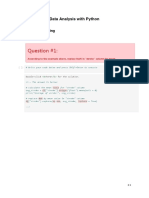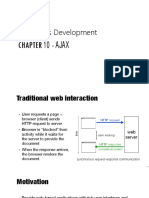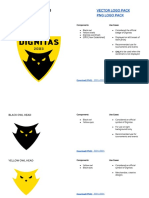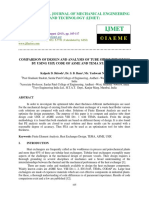Web Apps Development
CHAPTER 8 - SERVER SIDE PROGRAMMING 3
8-1
Server-side programming
- Part I. handling requests
- Part II. templating
- Part III. MySQL
- Part IV. cookies and sessions
8-2
Storing data Files
Database
Internet
Client Server
Cookie Session
8-3
Using MySQL from Python
8-4
Connectors
- Low level connectors vs. Object-relational mapping (ORM)
- Many packages for low level connection
- Most of them are compliant with the Python Database API Specification
(PEP 249) https://www.python.org/dev/peps/pep-0249/
- We will be using MySQL Connector/Python
- "Official" connector
- https://dev.mysql.com/doc/connector-python/en/
- Part of Anaconda, but needs to be installed
conda install mysql-connector-python
8-5
Python Database API Specification
- Two main objects
- Connection
- Cursor
- Connection methods
- cursor() returns a new Cursor
- close() closes connection to DB
- commit() commits any pending transactions
- rollback() rolls back to the start of any pending transaction (optional)
8-6
Connecting to a DB
import mysql.connector
conn = mysql.connector.connect(user='root', password='root',
host='127.0.0.1', database='dat310')
# do some stuff
conn.close()
- The connect() constructor creates a connection to the
MySQL server and returns a MySQLConnection object
8-7
Error Handling
examples/python/mysql/mysql1.py
from mysql.connector import errorcode
try:
conn = mysql.connector.connect(…)
except mysql.connector.Error as err:
if err.errno == errorcode.ER_ACCESS_DENIED_ERROR:
print("Invalid username/password.")
elif err.errno == errorcode.ER_BAD_DB_ERROR:
print("Database does not exist.")
else:
print(err)
else:
# do some stuff
conn.close()
8-8
Python Database API Specification
- Cursor methods/attributes
- execute() executes a database operation or query
- rowcount read-only attribute, number of rows that the last execute
command produced (SELECT) or affected (UPDATE, INSERT, DELETE)
- close() closes the cursor
- fetchone() fetches the next row of a query result set
- fetchmany() fetches the next set of rows of a query result
- fetchall() fetches all (remaining) rows of a query result
- arraysize read/write attribute, specifying the number of rows to fetch
at a time with fetchmany() (default is 1)
8-9
Creating a Table
examples/python/mysql/mysql1.py
cur = conn.cursor()
try:
sql = ("CREATE TABLE postcodes ("
"postcode VARCHAR(4), "
"location VARCHAR(20), "
"PRIMARY KEY(postcode))")
cur.execute(sql)
except mysql.connector.Error as err:
if err.errno == errorcode.ER_TABLE_EXISTS_ERROR:
print("Error: Table already exists.")
else:
print("Error: {}".format(err.msg))
else:
print("Table created.")
finally:
cur.close()
8 - 10
Dropping a Table
examples/python/mysql/mysql1.py
cur = conn.cursor()
try:
sql = "DROP TABLE postcodes"
cur.execute(sql)
except mysql.connector.Error as err:
if err.errno == errorcode.ER_BAD_TABLE_ERROR:
print("Error: Table does not exist.")
else:
print("Error: {}".format(err.msg))
else:
print("Table dropped.")
finally:
cur.close()
8 - 11
Inserting Data
examples/python/mysql/mysql1.py
sql = "INSERT INTO postcodes (postcode, location) VALUES (%s, %s)"
try:
cur.execute(sql, (k, v)) # data is provided as a tuple
conn.commit() # commit after each row
except mysql.connector.Error as err:
print("Error: {}".format(err.msg))
- Data is provided as a tuple (list of values)
- DELETE and UPDATE work the same way
- You must commit the data after these statements
8 - 12
Inserting Data (2)
add_salary = ("INSERT INTO salaries "
"(emp_no, salary, from_date, to_date) "
"VALUES (%(emp_no)s, %(salary)s, %(from_date)s, %(to_date)s)")
# Insert salary information
data_salary = {
'emp_no': emp_no,
'salary': 50000,
'from_date': tomorrow,
'to_date': to_date,
}
cursor.execute(add_salary, data_salary)
- It is also possible to provide data in a dict
8 - 13
Querying Data
examples/python/mysql/mysql1.py
cur = conn.cursor()
try:
sql = ("SELECT postcode, location FROM postcodes "
"WHERE postcode BETWEEN %s AND %s")
cur.execute(sql, ("4000", "5000"))
for (postcode, location) in cur:
print("{}: {}".format(postcode, location))
except mysql.connector.Error as err:
print("Error: {}".format(err.msg))
finally:
cur.close()
8 - 14
Object-Relational Mapping
- For Object-Relational Mapping (ORM), see SQLAlchemy
- https://www.sqlalchemy.org/
- Flask extension: http://flask.pocoo.org/docs/0.12/patterns/sqlalchemy/
users = Table('users', metadata,
Column('user_id', Integer, primary_key=True),
Column('name', String(40)),
Column('age', Integer),
Column('password', String),
)
users.create()
i = users.insert()
i.execute(name='Mary', age=30, password='secret')
s = users.select(users.c.age < 40)
rs = s.execute()
8 - 15
Using MySQL from Flask
8 - 16
Flask Contexts
- Flask provides two contexts
- request variable is associated with the current request
from flask import request
- g is associated with the "global" application context
from flask import g
- typically used to cache resources that need to be created on a per-
request case, e.g., DB connections
- resource allocation: get_X() creates resource X if it does not exist yet,
otherwise returns the same resource
- resource deallocation: teardown_X() is a tear down handler
8 - 17
Example
examples/python/flask/5_mysql/app.py
def get_db():
if not hasattr(g, "_database"):
g._database = mysql.connector.connect(…)
return g._database
@app.teardown_appcontext
def teardown_db(error):
db = getattr(g, '_database', None)
if db is not None:
db.close()
@app.route("/listall")
def list_all():
"""List all postcodes."""
db = get_db()
cur = db.cursor() The first time get_db() is called the
connection will be established
8 - 18
Example
examples/python/flask/5_mysql/app.py
- Contains examples of CREATE TABLE, INSERT, SELECT
(single/multiple records), DELETE
- Uses flashing for success messages
8 - 19
Exercises #1, #2
https://github.com/kbalog/web-programming/tree/master/
exercises/python/flask3
8 - 20
Resources
- Python Database API Specification
https://www.python.org/dev/peps/pep-0249/
- MySQL Connector/Python
https://dev.mysql.com/doc/connector-python/en/
- Flask
http://flask.pocoo.org/docs/0.12/quickstart/#
8 - 21





































































































